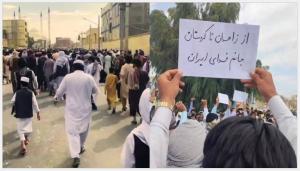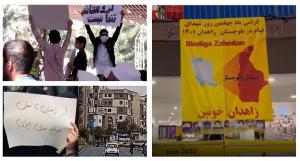(Video) Iran: Protests in Zahedan Outflank Regime’s Oppression and Plots
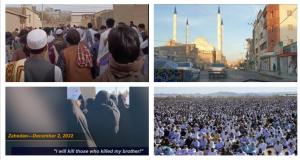
Three months into the nationwide Iran uprising, cities in Sistan and Baluchistan, southeast Iran, put on display the extraordinary courage of locals, mainly from the oppressed Baluchi minority, who rejected the regimes to portray them as separationists.
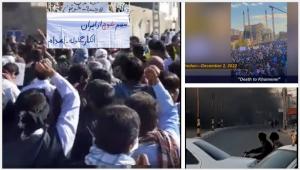
Yet again, this Friday, security forces opened fire on unarmed protesters and tried to disperse the crowd with bird shots and flying helicopters on top of the cities. Nevertheless, they failed to quash protests.
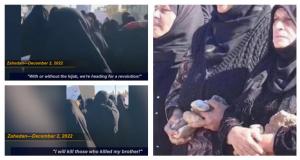
Among the most conservative regions in Iran, women in this province earned their place as trailblazers of the uprising by leading the Friday protests. They were heard chanting: “With or without Hijab, onward to freedom.”
By saying that “Kurds and Balochis are brothers; they are Khamenei’s enemy,” they once again emphasized that the common enemy is the ruling theocracy.
Despite the regime’s severe crackdown on previous protests in this province and the killing of over 130 unarmed protesters, demonstrators on Friday took to the streets chanting slogans against Iran’s ruling theocracy, particularly the supreme leader Ali Khamenei.
Yet again, this Friday, security forces opened fire on unarmed protesters and tried to disperse the crowd with bird shots and flying helicopters on top of the cities. Nevertheless, they failed to quash protests.
Friday’s protests in Sistan and Baluchistan were followed by dozens of other demonstrations across Iran, particularly in Arak and Izeh, where locals gathered to honor the martyrs. Reportedly, they vowed to continue their struggle for freedom by chanting, “We shall fight and take back Iran.”
These protests happened a few days after Khamenei sent his chief henchman, the Revolutionary Guards (IRGC) commander Hossein Salami, to Sistan and Baluchistan province, trying to intimidate the public while speaking of “reforms.”
Salami was the second representative Khamenei had sent to the restive province in the last three months. As Khamenei’s special representative, Mohammad Javad Haj Ali Akbari paid a visit to Zahedan, Sistan and Baluchistan’s capital, speaking with the Sunni clerics in a bid to decrease tensions and portray the conflict in the Sunni-dominated cities as a “mistake.”
But a few days after, people poured onto the streets, debunking the regime’s claims of reform or the futile efforts to downplay the cold-blooded killing of innocent civilians.
Last Friday’s protests, with people calling out the entire regime, indicate the increasing public vigilance and deep awareness. Locals were heard chanting: “We didn’t sacrifice martyrs to negotiate with the murderous leader,” referring to Khamenei.
The Friday protests demonstrated a stunning national unity, as Baluchi protesters were holding signs and placards while chanting slogans in solidarity with other regions of Iran, namely their Kurdish brothers.
By saying that “Kurds and Baluchis are brothers; they are Khamenei’s enemy,” they once again emphasized that the common enemy is the ruling theocracy.
But what made last Friday’s demonstrations in Sistan and Baluchistan unique was the widespread presence of Baluchi women on the frontlines of protests.
Among the most conservative regions in Iran, women in this province earned their place as trailblazers of the uprising by leading the Friday protests. They were heard chanting: “With or without Hijab, onward to freedom.”
Their presence, as well as their slogan, rejects the Iranian regime and its pundit’s theory that Iran’s democratic revolution demands, particularly the women’s claims, are narrowed to some basic needs rather than freedom, democracy, and regime change.
Since the beginning of the nationwide uprising, the Iranian regime has struggled to target national unity or vulgarize what many consider Iran’s revolution by painting protesters as foreign agents, separationists, and perverts.
Yet, the people’s national unity and common goal of achieving democracy have indeed outflanked the regime’s pathetic efforts.
The continuation of protests, against all odds, not only shows the people’s unwavering determination to regime change but foretells the beginning of a new era in Iran and that fear has shifted to the regime’s camp.
In his last speech on November 26, Khamenei claimed that people’s demands were the ones shouted by his paid agents in state-staged protests. Hence, people’s slogans such as “death to Khamenei” and “death to the dictator” indeed called his buff.
This bravery, amid the regime’s endless plots and violence, deserves more concrete international support and practical ways to end the regime’s brutality, such as recognizing the Iranian people’s right to self-defense and cutting all ties with Tehran. These actions certainly send a message of strength to Khamenei, pushing his regime to the edge of downfall.
Shahin Gobadi
NCRI
+33 6 61 65 32 31
email us here
In his last speech on November 26, Khamenei claimed that people’s demands were the ones shouted by his paid agents in state-staged protests.
Legal Disclaimer:
EIN Presswire provides this news content "as is" without warranty of any kind. We do not accept any responsibility or liability for the accuracy, content, images, videos, licenses, completeness, legality, or reliability of the information contained in this article. If you have any complaints or copyright issues related to this article, kindly contact the author above.

